My Mygale M13-SJ/Mountune [Formula Ford EcoBoost 200]
I bought my Mygale EcoBoost, in August 2015. [Sarl Mygale is a french manufacturer of formula chassis'] The SJ01-13 chassis is fitted with a Ford EcoBoost 1600T, and a Hewland FTR 6 speed sequential gearbox with an open (non-LSD) diff. When sold in 2013 the standard factory Mygale featured drive-by-wire, with clutchless up and down shifts using a gear lever, managed by a bespoke Life F88R ECU adapted for EcoBoost GDI.
Back in 2013, Radical Sportscars (UK) entered two cars in the MSA British Formula Ford Championship. One was driven by James Abbott, and the other was driven by Argentinian Juan Rosso. Both cars were prepared and run by Radical, and attended all the race meetings around the UK in 2013 and 2014. However, at the end of the 2014 season, the MSA Formula Ford championship was no more, and both Formula Fords sat at the Radical HQ for almost a year before Pete Goulding and I went to see them in August 2015.
After striking a deal with Radical, I bought James' black car, and Pete bought Juan's car. Pete's car was white, but is now wrapped in orange vinyl. Both cars were of similar spec, with minor differences between them. We collected the car's in August 2015, and immediately started making plans for 2016.
In 2016, my first year driving the single seater, I competed in 13 hillclimb and sprint events, and won one first in class at Loton Park hillclimb. I also scored my first points in the British Sprint Championship, which I'm very proud of, considering the lack of power and aero compared to the regular front runners.
Keeping my car standard for 2016, I learnt a lot about the performance during the year, and drove in the wet and in the dry, with no mechanical issues, and just a couple of spins along the way. I fitted Avon A15 slicks to the Rimstock rims, and used the Goodyear wets when the weather dictated.
Pete upgraded his car for 2016, fitting Force split rims, a larger Pro-Alloy intercooler, and he also tuned the car for 220BHP, and ran less weight through the removal of the impact protection boards (approx 16kg weight reduction). Pete also relocated his alternator to the front of the engine, and ran all year without any battery issues.
For 2017 Pete and I fitted more powerful Hybrid turbos, and I've also fitted a larger Pro-Alloy intercooler. I converted to paddle shift, using a Syvecs X10 interfaced to the Life ECU, to control the actuators and read the paddle switches that I'd fitted to the steering wheel. I also reduced the weight of my car by removing the side impact boards (16kg), in an attempt to maintain the performance level between us, and to make my car yet more competitive in the British Sprint Championship. I also relocated the alternator to the front of the engine, and I wired in the radiator fan so it was under the control of the ECU. My car was tuned to produce 313bhp, which was an increase of over 140bhp from the standard engine, and that put me on par with the 300bhp two litre normally aspirated cars that regularly win FTD and finish in the top 5 at BSC rounds. In 2017 I had a good year, with lots more records set, and I scored 26 points in the BSC, and finished 14th. My achilles heel was the standard Mygale aero, which didnt really do a great deal for performance.
In 2018, I stayed with the same Turbo Technics S242 hybrid turbo, and invested heavily in a set of carbon fibre front and rear wings from Simon McBeath/DJ Racecars, and the wings made a huge difference to the car, allowing me to score 63 points in the BSC placing me 9th overall. I fitted a Lithium battery instead of the Lead Acid, which saved 4Kg weight. Triple M motorsport set the chassis up for me at the start of the year, and corrected various alignment issues. I changed the front and rear springs too, to combat the ride height issues I was experiencing from the increased downforce, resulting in 950lb.in springs on the front and 1150lb.in on the rear. I also had the car tuned again in June 2018, in which we found the car was 50hp down on the 313bhp that it was meant to have made in 2017, and the result with some increased fuelling was over 320bhp, which during the middle of the season, gave me a massive performance increase. After that I managed a 3rd place overall (Rockingham) and an FTD in the wet at Blyton, on my way to finishing 9th overall in the BSC, a very pleasing result for all the hard work. I regularly beat Pete, and finished two places higher in the BSC, though I lost out to Pete in the 1600T Class after I missed the final round at Anglesey due to a slight accident the day before.
In 2019, at Knockhill, the Mountune engine blew up on the final run of the weekend placing me 8th overall in the British Sprint Championship; so I had the EcoBoost engine rebuilt by Ian Howell of Area 6, using fully forged internals, and I upgraded the turbo to a Turbo Technics S280, which produced 375bhp at SRD Tuning in March 2020. The car was used several times in 2020, and is ready and raring to go when the pandemic restrictions lift in 2021. The outings in 2020 were spent setting up launch and traction control to accomodate the extra power, and at Castle Combe in October 2020 I finished 3rd overall, with a growing confidence in the car and the driver. Fuel surge had been eliminated also, by fitting a Radium anti-surge tank.
So what is a Formula Ford 1600T EcoBoost?
Have a watch of this video to get an idea, then read on.
The Mygale M13-SJ/Mountune, the car I have, is a 2013 version of the car that was first released in 2012. These were raced in the Formula Ford Champships between 2012 and 2014. My car was first raced in 2013 under Scholar Power, the engine was changed to Mountune, and then it won two races in 2014, Brands Hatch on March 29th, and Croft on June 29th, with James Abbott at the wheel on both occasions. Radical started with a different chassis in 2013, a Sinter LA12, but after failing to make the car competitive, they sold it and bought the Mygale M13-SJ, which then led to the two race wins for James in 2014.
A full history of the championship and the cars successes can be found on the Wikipedia Formula Ford page.
Where the story starts, August 2015
22Aug
I collected the Mygale M13-SJ/Mountune Formula Ford from Grantham. Radical let me use a spare Brian James Race Shuttle, which is a clamshell trailer that opens at the rear to allow the car to be stored inside. It had a tyre rack too. So we loaded the majority of the 26 wheels and tyres in the trailer, around the car, and the remainder of the tyres inside the BMW, and set off.
Once home the trailer and car were quickly unloaded. After lunch, I set off back to Grantham again to return the empty trailer back to the Radical depot.
The single seater is simply amazing. I've worked out how to start the engine, and when it runs, it growls. If you rev the engine, the turbo spins up, and the exhaust makes a lovely popping and banging sound as the revs drop back down again. I've already started on the spanner check, I've found a few bits and pieces that need tidying up before I can drive it. But overall, with the spares package and the sheer number of wheels and tyres involved, I think the price we paid was pretty reasonable.
FTR Gearbox
The car is fitted with a Hewland FTR 6 speed sequential gearbox. It did not come with an LSD fitted. After a bit of searching I found that Quaife listed an LSD for the Hewland box on their website, unfortunately it was no longer manufactured. Plus the Quaife diff, part number QDF14S, is for the LJS/FTR gearbox, and the following explains the differences between the different boxes.The FTR (which is what I have) is a 6 speed box, with an engine oil tank.
The JFR is a 5 speed box, based on the FTR, but without the engine oil tank.
The JFR6 is a 6 speed box, based on the FTR, but without the engine oil tank.
The LJS version of the FTR/JFR has inserts fitted to the bearing housings of the side plate and main case to allow the use of differentials and output shafts from the LD200/Mk9 range of gearboxes. Therefore I would need an LJS/FTR if I wanted to fit the Quaife LSD. So that ruled the Quaife diff out.
The altnernative is the Hewland Powerflow FTR-212 LSD. I found one for sale in Germany, which cost €1200, and it arrived in January 2016. Dirk Jenichen supplied it, it was from one of his F3 cars. It was installed in February 2016 by Mark Bailey Racing. During the service he found that the CWP were damaged beyond repair, due to the gearbox running insufficient oil at some point, and I had to find another CWP quickly. Luckily there was one on Ebay which I bought, and Mark fitted it with no issues.
FTR Gearbox Ratios
The ratios inside the box are as per the following table/graph.
Life F88 ecu
The Mygale EcoBoost Formula Fords were all fitted with the Life F88R ECUs. However, this isn't the fully functioning F88-GDI4, but instead it is a locked down F88R, essentially lobotomised, produced specifically for the tightly controlled Formula Ford championship. This poses several serious questions. Could the ECU be unlocked to allow it to be tuned to increase the power output of the engine? And could the ECU be set up to provide traction control?So I wrote to one of the engine tuners familiar with the Life ECU range, and this was their response.
You are not the first person to ask this question and the short answer is you are not going to get the ecu unlocked.
Life racing sold the ecu’s to Ford as part of an MSA controlled championship and as such the IP (intellectual property) of the maps etc rest with Ford. Life racing are contractually bound not to unlock these ECU’s. They can re-flash the ecu and basically blank it but they are then faced with supporting a product that they have sold as a bulk deal to Ford at a drastically reduced margin, so that doesn’t make much business sense for them. The cost of rebuilding the map and rolling road time would not make this option attractive to you anyway.
Also the ecu was designed to fit that one car so they have limited IO and do not run the VVT (because the cars were traction limited anyway) and won’t run traction control.
The 170 bhp map was done because teams on a lesser budget insisted on running 95 octane fuel on test days etc and melted some engines so the maps were made safe for that fuel.
I think in 2013 a control fuel was introduced and the power went back up again.
If you want to run the engine with an open ECU then the only option is to upgrade to a LR GDi4 ecu which is £2250 and the traction control upgrade adds another £200. You would still have some rolling road time as well to configure certain items in the software.
You would need to add wheel speed sensors and additional wiring for the VVT if you want to use it (assuming its not locked off mechanically)
EcoBoost Power Outputs up to 2014
Curiosity drove me to email Life regarding the stories surrounding the different engine power outputs, namely 170BHP and 200BHP. Andy Laurence has apparently managed to get his ECU loaded with an earlier map, that supposedly produces 200BHP on pump fuel. As Pete and I have cars from the same team, we'd like to know which maps we have, and whether our cars are on the same footing power wise. We dont want to be 30 BHP down just because Andy has a different map to us. So I approached Life, and asked about the version that is in my ECU, and whether it was the 200BHP version or not. The issue we have is that Life say that it is against their company policy to load an old map in to the ECU, so whatever we've got, we're stuck with.I provided a screen shot of the base map version taken from the LifeRacing software connected to my laptop, and this was their response.
That is perfect. That was the last map for the 2014 season before preseason testing for FIA F4, that map is good. We do have a newer map on file that allows the car to start faster from cranking. Not really worth updating unless of course you want this feature.and then I asked how much power my car has. Not an unreasonable question. But it didnt furnish me with the response I was expecting.
Life worked with Ford and their partners to provide engineering and trackside support for the championship during 2012 to 2014. Life only worked directly with Ford and it's partners to manage this championship. Life does not hold any data for competitor engines as they are built and managed by the teams choosen engine builder. I would suggest you ask Mountune for dyno printouts of your engine. If I was you I would put the car on a rolling road and do a few power runs with 95ron fuel, then flush the entire fuel system out and repeat the test with 102ron fuel, you can then decide if the higher cost fuel offers any performance benefits or not.So from that, the conclusion I must draw, is that my car (and Petes if he has the same map) should be capable of 200BHP on Pump fuel. I shall contact Mountune again, and ask for a engine dyno map, which they must have as they provided the engine.
Mountune have since sent me the dyno plot from my engine, from when the engine was first built in 2013. Looks pretty healthy to me. If it were running 102RON fuel then it would be producing 30BHP more. I asked Mountune for the power output, and they said that the power was determined by the calibration map issued by Life. I asked Life and they said that it was the engine builders who knew the power output. Turns out no one knows.
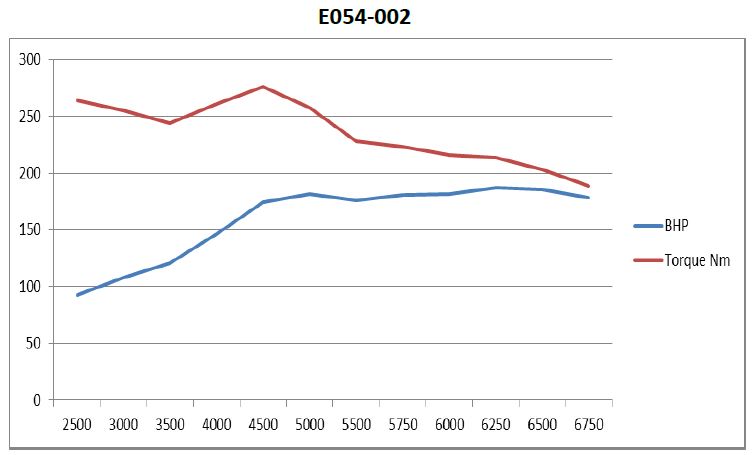
N---------- Motorsport
In 2016 N---------- Motorsport were appointed as the only approved Formula Ford EcoBoost FF200 tuner in the UK, and that meant that Pete and I would have to take our cars to them for the ECU's to be tuned. This relationship worked to a point, but we were still frustrated that the ECU's remained locked, and we couldnt see diagnostics information from the X10 IO Expander, or tweak the launch or traction control settings. After further continued pressure on Ford, I was successful in August 2018 in that Fords Calibration Manager finally agreed to allow access to our paid-for features. This meant that the Life ECU could be returned to Life, and they would (free of charge) unlock several exciting new areas of the config. These were: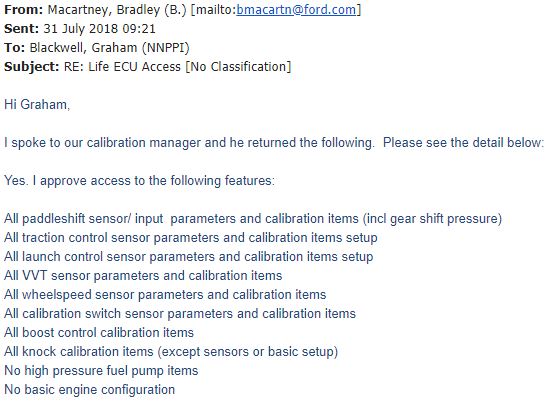
EcoBoost Power Outputs after 2014
Pete and I have made good gains with our EcoBoost engines. Pete hasnt had the best of luck with mechanical reliability, requiring two replacement engine rebuilds in the process, but we both have over 300ftlb and over 320bhp from the little 1.6T engines, just by changing the turbo's and fitting larger intercoolers.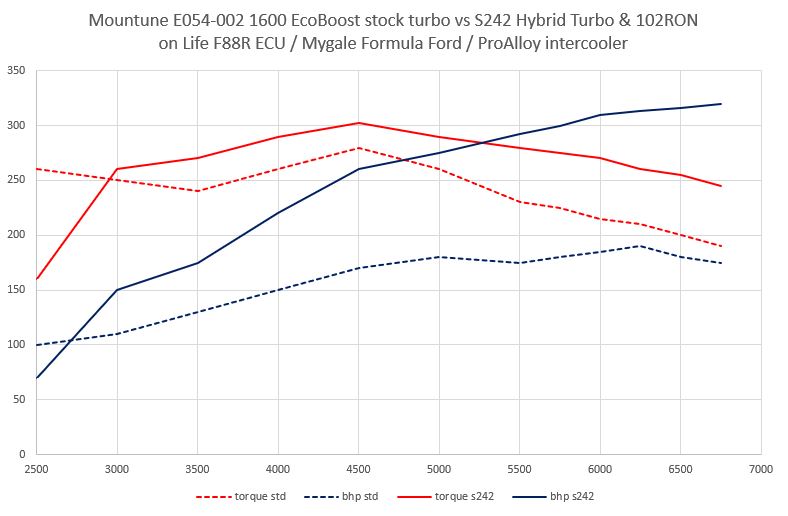
Devil Developments are the new tuners from 2020
In 2019, after several years of me badgering Ford, they allowed me to have my Life ECU fully unlocked. This was the ultimate solution, as I could then take the car to an EcoBoost specialist, Devil Developments, who worked wonders in March 2020, resulting in 375bhp and 405lbft of torque using the Turbo Technics S280 turbo, 102 octane race fuel, and the Aera 6 closed deck engine.Mountune engine
 As I've already mentioned, the original engine in my car, was built by Mountune Racing and it was supplied in October 2013, so it had only done one full season of racing. We bought the cars in August 2015, a full year after the championship had finished, and during that sabbatical, the cars hadn't been driven. The engine in the sister car, bought by Pete Goulding was built by Scholar.
As I've already mentioned, the original engine in my car, was built by Mountune Racing and it was supplied in October 2013, so it had only done one full season of racing. We bought the cars in August 2015, a full year after the championship had finished, and during that sabbatical, the cars hadn't been driven. The engine in the sister car, bought by Pete Goulding was built by Scholar.When I contacted Mountune in September, to find the history of the unit, I was in for a shock. They told me that the engine number I gave was from a leased engine. Now, I hadn't heard of a leased engine before, but in motorsport apparently its very common for race teams to lease engines from a supplier. The contract with Mountune would have been for an engine, for a number of years, and that would include one possibly two rebuilds during the life of the engine, and at the end of the contract, the engine would be returned, to Mountune. What I discovered was that the engine was still on lease, and therefore wasnt even legally mine. How could Radical have sold me their car with a leased engine in it? All I can put it down to was an oversight, and fortunately when alerted Mountune to the problem, they contacted Radical and resolved it, presumably forcing Radical to purchase the engine off them.
Hi Graham,So that was a huge relief. There was me thinking Radical would have to buy the engine back off me, which wouldn't have been ideal. Fortunately, Mountune and Radical have resolved the issue, for which I'm most grateful. In the circumstances, if I ever buy another car from a race team, I'll certainly ask about the engine's identity and ownership.
Further to our conversation yesterday, engine E054-002 was new in October 2013 when it was leased to Radical. The engine is built to the upper tolerances for the manufactures limits (blue printed) as permitted by the Formula Ford regulations.
We do not have any records of it having been returned since October 2013 for repair or service.
If my memory serves me correctly I believe that we suggested that the turbo was replaced half way through 2014, but I believe Radical replaced this themselves.
This is all the history I have on the engine.
I have also spoken with Phil Abbott and the engine purchase issue is being resolved.
Regards,
Russell Sames
FIA Chassis Approval & the ROPS saga
This is a copy of the FIA Email, dated October 2012. It reads:We are pleased to confirm officially that the safety structures of the above mentioned car were successfully tested under the supervision of the FIA according to the requirements detailed in 277-2.2.1.1.
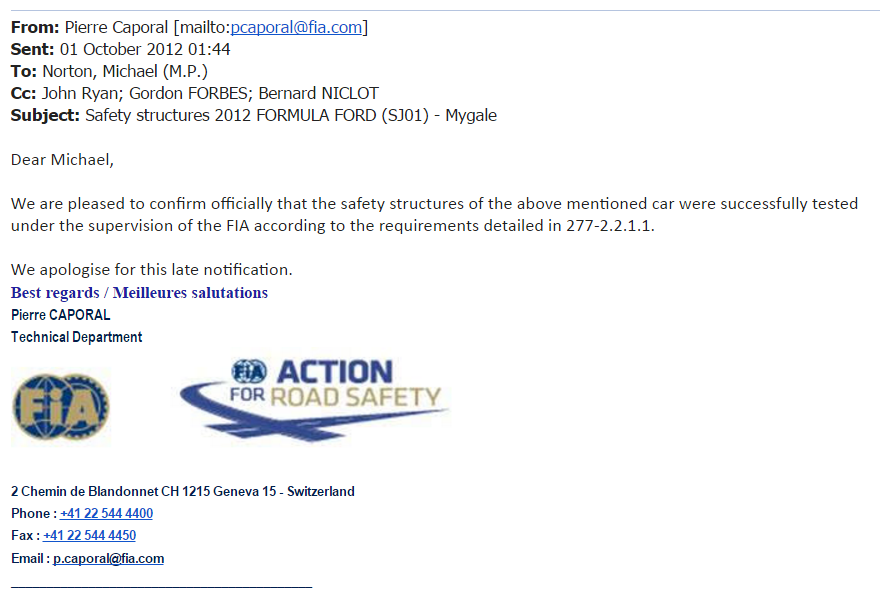
That was all we had to prove that the cars were tested and compliant, and much to everyone's dismay, the MSA introduced from 2017, a mandatory ROPS certificate requirement for all cars being sprinted and hillclimbed. Roll over protection, or ROPS as everyone knows it, is the protection for the driver in the event that the car was inverted. A user of the the Uphillracers.com forum, brought this to everyone's attention in the summer of 2016, and that gave me 9 months to find the certificates for our cars. Long story short, after 9 months of continued emails, Ford paid for the production of the certificates, and we were ready in March 2017 to show them at scrutineering. Basically, Mygale had paid for the FIA Safety Tests, but embarrasingly, they'd not applied for the certificates. So I had to get the MSA to speak to Mygale and Ford, to get them both to speak to each other, to raise the ROPS paperwork. The good news now, is that anyone with an SJ01-12 EcoBoost car, can easily obtain the certificates from the MSA, and are therefore allowed to sprint and hillclimb that chassis. It was 9 months of totally unnecessary stress, but had I not got involved and pushed for the generation of the certificates, no one would have raced an EcoBoost Mygale at a sprint or hillclimb in 2017 or beyond.
Modifications
For the FF championship, the minimum weight of the car was controlled at 475Kg (the Mygale SJ12 manual actually states the car weighs 485Kg). Basically, any driver below 80Kg in weight would be required to carry ballast to bring the combined weight up to 555Kg. As I found no ballast, I can rightly assume that James Abbott weighed 80Kg (or more). For sprinting and hillclimbing there is no minimum weight, so I can remove or replace items with lighter versions. Adding lightness is the key.These are the items I’ve weighed, and either kept or removed. Significant reductions still be made from several routes. In 2017 I shall be changing from the standard cast alloy wheels for three piece split rims, to save 2-4Kg. Also for 2017 I have removed the anti-intrusion sheets from inside the car, as these weighed in at 16Kg. At the end of 2016 I removed the plumbed in fire extinguisher system.
| Item | Weight (grammes) | Removed | Added |
| Front Tethers | 519 | 519 | |
| Rear Tethers | 350 | 350 | |
| Undertray | 8500 | ||
| FIA Extractable Seat + extraction belts | 1489 | 1489 | |
| Head restraint | 2176 | 2176 | |
| Diolin anti-intrusion panels (pair) and fasteners | 16000 | 16000 | |
| Silicon air inlet pipework | 846 | 846 | |
| 63mm 0.55m ducting hose (air inlet) | 185 | 185 | |
| Rear crash box | 1325 | ||
| Front crash box with aluminium wing brackets | 3600 | ||
| Front wing (with end plates) | 4400 | ||
| Front wing end plates (pair) | 1750 | 1750 | |
| Rear wing end plates (pair) | 3300 | ||
| 2.25L mechanical extinguisher system | 3500 | ||
| Hand brake pull T-cable | 250 | 250 | |
| Rear 8.5 x 13 inch cast wheel with A15 230/530 tyre | 12000 | ||
| Rear 10.5 x 13 inch Force wheel with A15 250/570 tyre | |||
| Front 7.5 x 13 inch cast wheel with A15 190/530 tyre | |||
| Front 8.5 x 13 inch Force wheel with A15 190/530 tyre | |||
| Oil cooler and hoses | 7500 | 7500 | |
| Alternator bracket + driveshaft pulley | 750 | 750 | |
| Neutral cable assy | 345 | 345 | |
| Rear ARB assy | 929 | 929 | |
| Gear change cable | 698 | 698 | |
| Gear lever and strain gauge | 279 | 279 | |
| Varley red top 15 battery | 5500 | ||
| Lithium battery | 850 | ||
| Mirrors | 250 | 250 | |
| Total | 37631 | 185 |
Weight of car in 2017
April 2017 - The car weighs 453Kg, dry, on the Rimstock alloys and Dunlop wet tyres. The Force racing wheels and Avon slicks reduce the weight by some 3Kg, so the car is bang on 450Kg for 2017, fitted with the X10, pneumatic paddle shift, and the Revo turbo and Pro-Alloy intercooler. Thats 25Kg less than the minimum weight the cars had to run when raced in the Formula Ford championship. All I need to do now is fit the Lithium battery to save another 5Kg.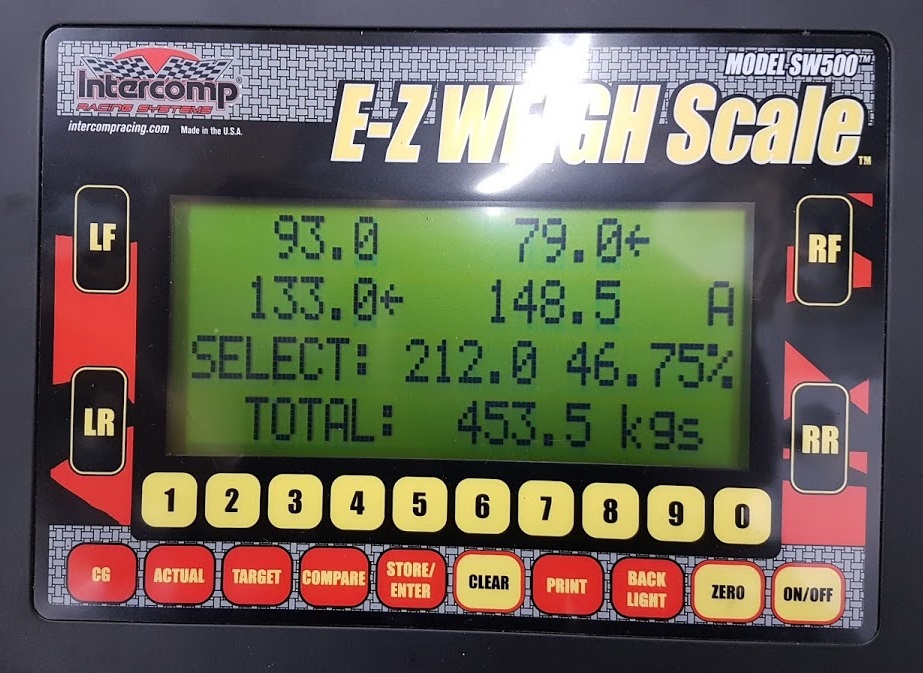
Syvecs IO Expander
July 2016 I bought a Syvecs IO 10 expander module. This connects to the CAN BUS and provides additional IO to allow me to use rear wheel speed sensors for launch and traction control. This is being wired in to CAN 02 from the F88R to provide the expansion I need to add the sensors.
The biggest hurdle to fitting anything to the cars, is finding a set of wiring schematics. Ford wont release them, as they're their intellectual property, and so I set myself a task of tracing all the wires through on my spare engine loom, to allow me to produce a diagram. As of January 2017 I've completed 99% of this task, and I'm now wiring in the X10. Part of the problem with connecting the X10 to the Life ECU, is that the X10 needs to connect to CAN 02. To do that, I had to buy some crimp connectors, dismantle the back shell from the F88 loom, and carefully add the two wires. This wasnt as difficult as I'd imagined, and the X10 is now connected to pins 79 & 80 from the F88R ECU which will allow the 10 inputs and 10 outputs on the X10 to be controlled by the ECU.
In 2021 I rewired the X10 to allow me to connect the four suspension potentiometers to the ECU inputs. I also wired in the Exhaust VVT Cam sensor, and the VVT Solenoid, so the ECU can control the Exhaust cam for the very first time.

